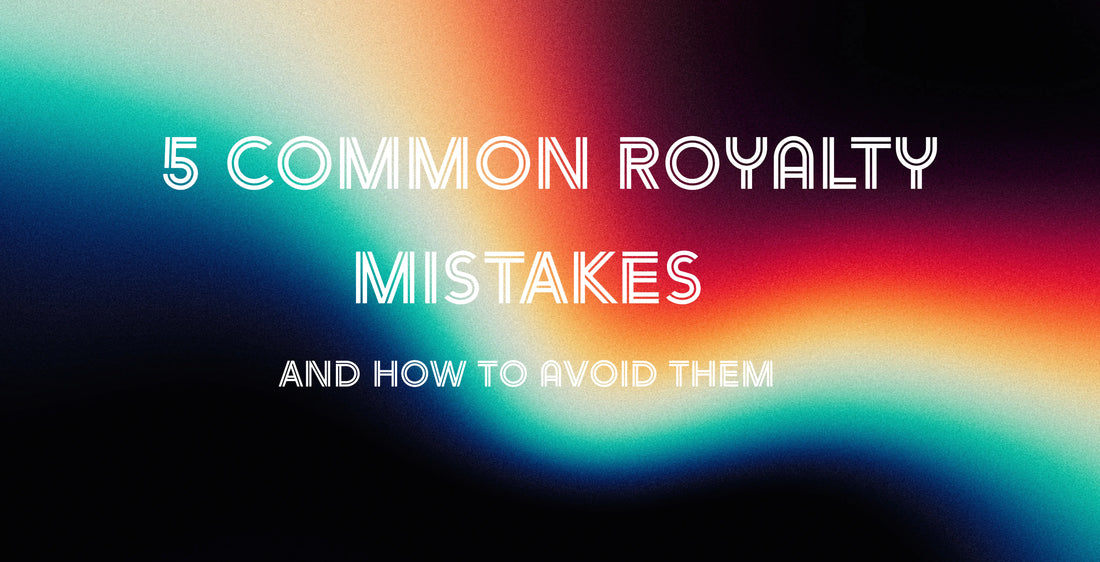
5 Common Royalty Mistakes YouTube Creators Make (And How to Avoid Them)
Share
YouTube has become one of the most powerful platforms for creators, musicians, and content entrepreneurs. But if you're uploading videos or using music in your content, there's a good chance you're leaving royalty money on the table—or worse, putting yourself at legal risk.
Whether you're a beatmaker uploading instrumental videos, a podcast host sharing interviews, or a filmmaker posting shorts, understanding music royalties and rights is non-negotiable if you want to grow and monetize your channel long-term.
In this post, we’ll break down the 5 most common royalty mistakes YouTube creators make, explain why they matter, and show you how to fix them.
❌ Mistake #1: Using “Royalty-Free” Music Without Reading the License
Royalty-free doesn’t mean free-for-all. It simply means you don’t have to pay recurring royalties—but you still need the correct license.
Many creators download tracks from royalty-free platforms (like Epidemic Sound, Artlist, or AudioJungle) and assume they’re covered. But each platform has different rules:
- Some require active subscriptions to maintain usage rights.
- Others limit usage to personal content, not brand work or sponsorships.
- Some don’t allow re-uploading or remixing in any way.
🚫 Example: A vlogger uses a song from a subscription library in a sponsored video after their subscription ends. The result? A copyright claim and loss of monetization.
✅ Fix:
- Read the license agreement carefully.
- Use music platforms that issue clear licenses with commercial rights.
- Keep records of downloaded licenses, especially for brand deals.
❌ Mistake #2: Not Registering Original Music with a PRO
If you’re creating and uploading your own music to YouTube but haven’t registered it with a performance rights organization (PRO) like ASCAP, BMI, or SESAC (or PRS, SOCAN, etc. internationally), you’re missing out on backend royalties from YouTube’s Content ID system and other sources.
YouTube reports performance data to PROs, which then pay out royalties for public performances of your work—even from other people’s uploads of your music.
💸 Example: A beatmaker uploads tracks weekly, some of which are used in thousands of creator videos. They’re missing royalties because the tracks aren’t PRO-registered.
✅ Fix:
- Register your original compositions with your PRO.
- Link your catalog to YouTube’s Content ID via a distributor like CD Baby, TuneCore, or AdRev.
❌ Mistake #3: Relying on YouTube’s Audio Library Without Strategy
YouTube offers a large library of free tracks and sound effects—but most of those tracks are not eligible for monetized usage outside of YouTube, and some even require attribution or limit usage in sponsored content.
Additionally, relying on the same public library music as everyone else makes your content less distinctive.
🧠 Example: A creator uses a generic ukulele track from YouTube’s library and gets flagged when using it in a YouTube ad. Why? It wasn’t cleared for advertising use.
✅ Fix:
- Use YouTube Audio Library tracks only when attribution and rights are fully understood.
- For brand work or premium content, use licensable commercial music with full documentation.
- Consider commissioning or licensing unique music to elevate your brand.
❌ Mistake #4: Not Monetizing Your Music Separately
If you're a musician uploading your own music to your channel—but only earning ad revenue through YouTube—you’re missing multiple royalty streams.
Many creators forget to:
- Register tracks for YouTube Content ID
- Release music via a distributor to collect Spotify/Apple Music royalties
- Monetize tracks on TikTok, Reels, and Shorts platforms
🎧 Example: A lo-fi producer uploads full-length beat videos to YouTube but doesn’t release the music to DSPs or register with a PRO—losing backend and streaming revenue.
✅ Fix:
- Distribute your music to DSPs using a platform like DistroKid or Amuse.
- Use Content ID services to monetize third-party use.
- Register with a PRO and make sure your name and IPI number are accurate.
❌ Mistake #5: Ignoring Copyright Claims or Disputing Everything Automatically
When you receive a copyright claim on YouTube, it doesn’t always mean you’re in trouble. Some claims are legitimate (you used music without a license), while others are automated and can be disputed if you have the proper rights.
Creators often:
- Ignore claims and lose monetization
- Dispute all claims without understanding legal standing
- Fail to track which music is claimed and why
🛑 Example: A YouTube short is flagged by Content ID because a beat you used is licensed exclusively elsewhere. You dispute it—and lose both monetization and platform trust.
✅ Fix:
- Keep detailed records of where your music came from and what rights you have.
- Only dispute claims when you have proof of license or ownership.
- Use platforms like Identifyy, AdRev, or your distributor’s backend to manage claims and revenue.
🚀 Final Thoughts
YouTube is one of the most powerful platforms to grow as a creator and monetize your music—but only if you understand how royalties actually work.
When you take your music rights seriously, you unlock multiple income streams:
- Ad revenue
- Performance royalties
- Streaming royalties
- Micro-sync and Content ID
- Licensing to other creators and brands
Protect your music. Track your rights. And turn every upload into an asset that keeps working for you long after the views stop climbing.
Need help setting up Content ID, managing rights, or licensing your catalog?
🎧 Work with Playbutton Media — we help creators and musicians protect, package, and monetize their work the smart way.
